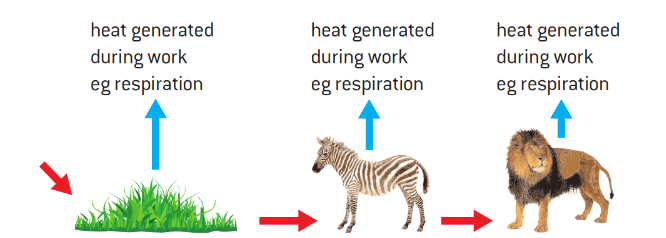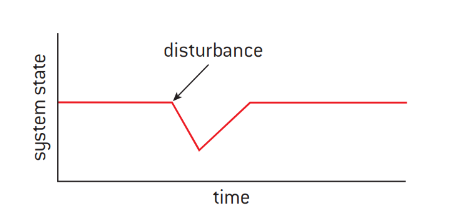TOPIC 1.3 - ENERGY and EQUILIBRIA
LAWS OF THERMODYNAMICS
1st. the law of conservation of energy - energy cannot be created or destroyed but only transformed or transferred
modelled by energy transfers and transformations within system diagrams, food webs and food chains
energy within an isolated system (e.g. the universe) is constant - amount does not change over time
2nd. the law of entropy - states that the entropy of a system increases over time
entropy (def). measures the amount of disorder within a system
disorder refers to the dispersal and loss of energy
an increase in entropy increases the amount of energy lost in transfers and transformations - reducing the energy available for growth
inefficiency increases as energy and biomass moves through trophic levels
heat as a form of energy has a high amount of entropy, and is therefore a low quality form of energy
 losses through food chains
losses through food chains
STABILITY
feedback loops (def). ways in which systems respond to change, set into two categories
negative feedback loops (def). counteracts deviation, usually to restore the system back to its original state - is a form of self regulation for the system
e.g. rising global temperatures → icecaps melting → more available water → more clouds created → solar radiation reflected by clouds → temperatures fall
positive feedback loops (def). builds on deviation and usually moves the system further away from its original state, causing in to pass a tipping point and establish a new state
e.g. rising global temperatures → ice caps melt → exposed soil → absorbs more solar radiation → decrease in earth’s albedo → temperatures continue to rise
albedo (def). the reflecting ability of a surface or thing
equilibrium (def). the tendency of a system to return to its original state following a disturbance OR a state of balance between the components of a system
steady state equilibrium (def). a characteristic specific to open systems where there are constant inputs and outputs but overall the system remains in a constant state where there are no large changes over time
achieved through negative feedback mechanisms
e.g. a water tank where an equal amount of water is flowing in as is flowing out - allowing a constant amount of water to be in the tank at all times
e.g. a population of ants where the birth and death rates are evenly matched, allowing a constant population size
 e.g. human body temperature as a steady state equilibrium
e.g. human body temperature as a steady state equilibrium
systems can have a stable or unstable equilibrium
stable - tends to return to the same state after a disturbance - uses negative feedback loops
 stable equilibrium
stable equilibrium
unstable - tends to end up at a new equilibrium after a disturbance - uses positive feedback loops
 unstable equilibrium
unstable equilibrium
static equilibrium (def). a system in which there is no change over time - when disturbed the system develops a new state or equilibrium
often seen in non-living systems - e.g. building or piles of inanimate objects
cannot occur in living systems - will always be transfers of energy and matter
resilience (def). refers to how well a system responds, recovers and returns to its equilibrium after a disturbance
low resilience = new state
high resilience = original state
factors of resilience :
climate - colder climates will have slower growth rates - affecting the systems ability to recover from disturbance
genetic diversity - species are able to replace others in case of disease or the extinction of one species
area - larger area is likely to come with more biodiversity as well as more space for organisms - reducing need for disease and competition
diversity and complexity - more interactions for the system to fall back on
tipping points (def). the point where an ecosystem shifts to a new state - involving noticeable changes in its organisms and what it can provide
changes are long lasting and difficult to reverse
are a result of positive feedback
e.g. death of a coral reef OR extinction of a keystone species